flexuous, adj; Full of bends or curves; sinuous.
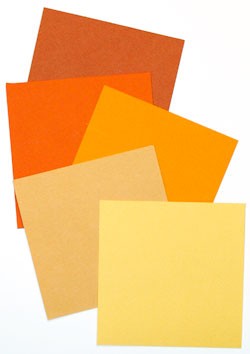 Last Monday I stopped into a store that sold handmade journals here in Santa Fe. One of the journals used the same fold I used in last week’s prompt challenge, only instead of putting them on a backing sheet, she stacked and glued them. When opened, the pages were quite sinuous — almost like playing with a slinky! I immediately knew I’d use that structure for this week’s word.
Last Monday I stopped into a store that sold handmade journals here in Santa Fe. One of the journals used the same fold I used in last week’s prompt challenge, only instead of putting them on a backing sheet, she stacked and glued them. When opened, the pages were quite sinuous — almost like playing with a slinky! I immediately knew I’d use that structure for this week’s word.
 When I was making collages a couple of weeks ago, I’d run across some paper I’d bought for a project years ago — Canson mi-tienes in coordinating colors (see to the left). The colors made me think of summer. I used them to make a model of the structure and hung it up in my studio — that’s it on the right.
When I was making collages a couple of weeks ago, I’d run across some paper I’d bought for a project years ago — Canson mi-tienes in coordinating colors (see to the left). The colors made me think of summer. I used them to make a model of the structure and hung it up in my studio — that’s it on the right. 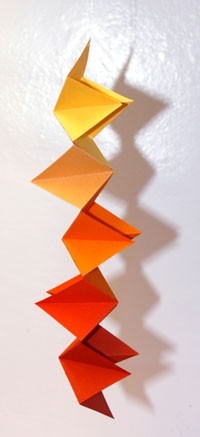 The result had a wonderful springy elastic quality, and hanging it allowed me to admire the colors.
The result had a wonderful springy elastic quality, and hanging it allowed me to admire the colors.
 I’ve always loved mobiles (as a kid, I remember seeing Calder mobiles at museums and being fascinated). My collages often have a cascade of coordinating colors, and I thought it would be interesting to use strands of the folded paper to turn my collages into something 3D by making a mobile.
I’ve always loved mobiles (as a kid, I remember seeing Calder mobiles at museums and being fascinated). My collages often have a cascade of coordinating colors, and I thought it would be interesting to use strands of the folded paper to turn my collages into something 3D by making a mobile.
 The squares for the model on the right are 4″. I thought that was too big, so I made several chains of various sizes. I liked the results with 1″ squares best, but I couldn’t really tell if the mobile would be what I wanted with just one strand. I hoped a model with 9 strands would tell me — and while that was a lot of folding, it went rather quickly by coupling the folding with mindlessly watching TV!
The squares for the model on the right are 4″. I thought that was too big, so I made several chains of various sizes. I liked the results with 1″ squares best, but I couldn’t really tell if the mobile would be what I wanted with just one strand. I hoped a model with 9 strands would tell me — and while that was a lot of folding, it went rather quickly by coupling the folding with mindlessly watching TV!
 You can see the result below. Once constructed, unfortunately the strands aren’t really bendy or sinuous anymore. It reminds me of chimes. This afternoon it was quite warm, and I had the door open. The gentle breeze that came through rustled the paper strands together, making a lovely musical sound.
You can see the result below. Once constructed, unfortunately the strands aren’t really bendy or sinuous anymore. It reminds me of chimes. This afternoon it was quite warm, and I had the door open. The gentle breeze that came through rustled the paper strands together, making a lovely musical sound.

Next up: profluent, adj; Flowing smoothly or abundantly forth.
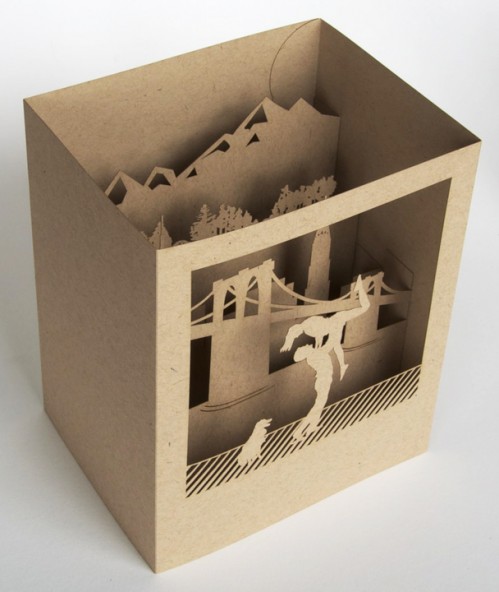 I buy a lot of paper from French Paper, and the other day I ran across a website they’ve set up to show off projects using their papers—the French Sample Room. That’s where I found this tunnel book. They don’t seem to link back to the original designer, unfortunately.
I buy a lot of paper from French Paper, and the other day I ran across a website they’ve set up to show off projects using their papers—the French Sample Room. That’s where I found this tunnel book. They don’t seem to link back to the original designer, unfortunately.
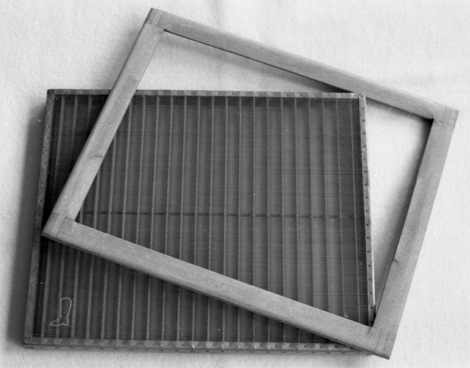
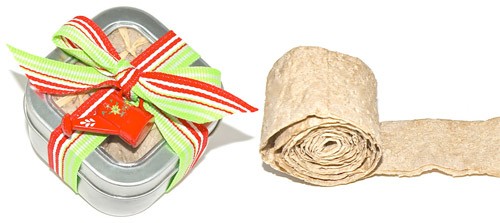
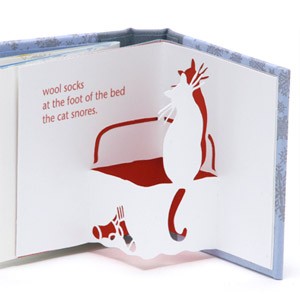
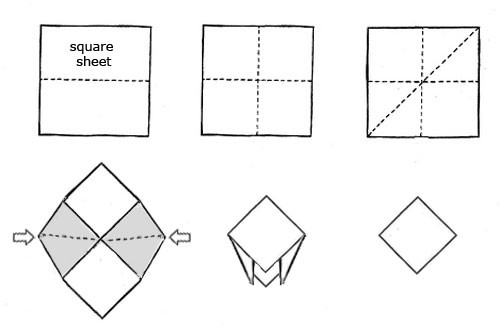

 Gluing the folded sheets back-to-back, and rotating each sheet 180 degrees as you glue, like the picture on the right, gives you an accordion book that has a wonderful slinky-like action to it. Below is a model I made that I hung up in my studio.
Gluing the folded sheets back-to-back, and rotating each sheet 180 degrees as you glue, like the picture on the right, gives you an accordion book that has a wonderful slinky-like action to it. Below is a model I made that I hung up in my studio.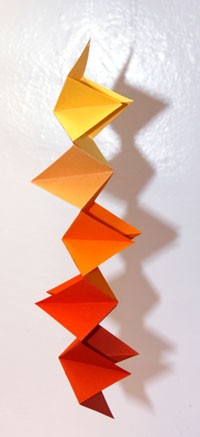
 Last Monday I stopped into a store that sold handmade journals here in Santa Fe. One of the journals used the same fold I used in
Last Monday I stopped into a store that sold handmade journals here in Santa Fe. One of the journals used the same fold I used in  The result had a wonderful springy elastic quality, and hanging it allowed me to admire the colors.
The result had a wonderful springy elastic quality, and hanging it allowed me to admire the colors.